The Indices report shows the evolution of a folio's EVM metrics over time. EVM metrics are grouped in three (3) categories: the Variance, Indices Report#Performance, and Estimate At Completion indices. Their evolution over time is represented in charts, one for each of the three indices categories. The report can be produced for printing, and its data can be exported to an Excel spreadsheet.
This report is only available when Earned Value Management is activated.
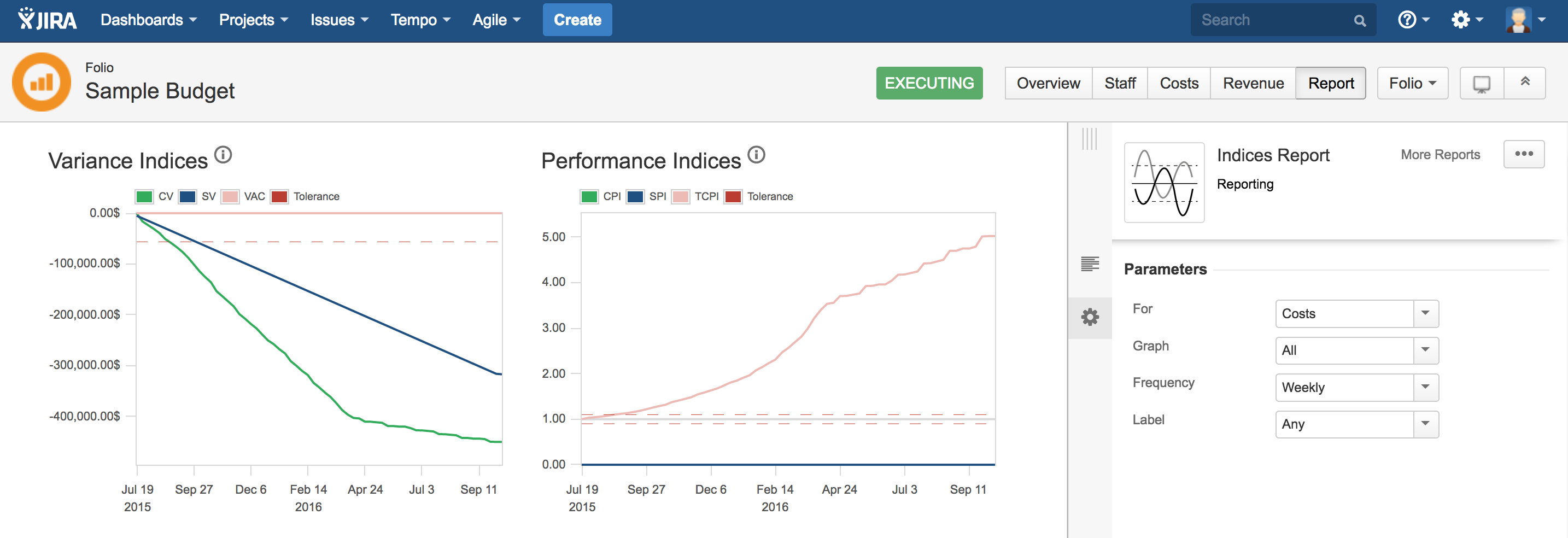
Configuring the report

|
For |
This allows you to display either Costs Indices or Revenues Indices |
|---|---|
|
Graph |
Graph to display: Variance Indices, Performance Indices, Estimate At Completion Indices, or all three graphs tiled side-by-side |
|
Display Results by |
This allows you to break down the information by week, 2 weeks, 4 weeks, Quarter, Calendar Year, or Fiscal Year. Total means no breakdown will occur; all issues for the selected period will be included in a single section. Note that report start date "day" will be the periods starting day. This means if your report start date is a Tuesday and the frequency is Weekly the report will display weekly expenses from Tuesday to next Monday. |
|
Label |
This allows you to display amounts for the selected Jira Issue Label. (not available at the portfolio level)
|
Variance Indices
The variance chart shows the trend of variance-related indices. The variance indices indicate how well the actual data compares to what was planned.

|
CV |
Cost Variance |
This index (CV) determines if the project is under or over the budget.
Ex: at the end of the fourth week the AC is 11,000.00$ and the EV is 8,000.00$ then the CV will be 3,000.00$ at the end of this period |
|---|---|---|
|
SV |
Schedule Variance |
This index (SV) determines whether the project is ahead of or behind schedule.
Ex: at the end of the fourth week the PV is 10,000.00$ and the EV is 8,000.00$ then the SV will be 2,000.00$ at the end of this period |
|
VAC |
Variance At Completion |
This index (VAC) determines whether the project will finish under or over planned cost or planned revenue. The Amount shown is the difference between the total planned cost or planned revenue and the Estimate at Completion
Ex: at the end of the fourth week the EAC is 250,000.00$ and the BAC is 200,000.00$ then the VAC will be 50,000.00$ |
|
TOL |
Tolerance |
The tolerance you have selected in your folio configuration |
|
|
Inline help |
|
Performance Indices
The performance chart shows the trend of performance-related indices. Performance indices attempt to capture how efficient the staff members is to convert money into earned value.
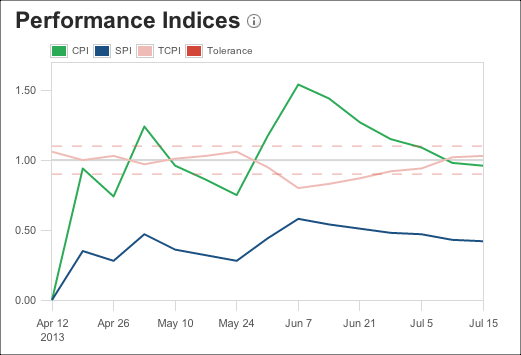
|
CPI |
Cost Performance Index |
This index (CPI) determines how efficiently the staff members are using the resources.
|
|---|---|---|
|
SPI |
Schedule Performance Index |
This index (SPI) determines how efficiently the project staff members are using their time.
|
|
TCPI |
To-Complete Performance Index |
This index (TCPI) determines the efficiency that must be achieved on the remaining work for a project to meet the Budget at Completion.
|
|
TOL |
Tolerance |
The tolerance you have selected in your folio configuration |
|
|
Inline help |
|
Estimate At Completion
This chart demonstrates the risk level trends. It displays the EAC (Estimate At Completion) based on three different approaches as describe below.
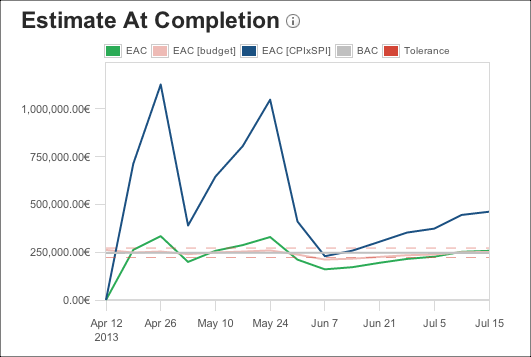
|
EAC |
Estimate At Completion |
This method assumes what the project has experienced to date can be expected to continue in the future. |
|---|---|---|
|
EAC [budget] |
Estimate At Completion Based on budget |
This method accepts the actual project performance to date and predicts that all future ETC(Estimate to Complete) work will be accomplished at the budgeted rate. |
|
EAC [CPIxSPI] |
Estimate At Completion Based on cpi and spi indices |
This method assumes that the ETC work will be performed at an efficiency rate that considers both the cost and schedule performance indices. |
|
BAC |
Budget at Completion |
|
|
TOL |
Tolerance |
The tolerance you have selected in your folio configuration |
|
|
Inline help |
|
Menu Options

Printing the report
Select the "Printable" item in the report's action menu found at the top right of the report's parameters panel or by hit "p" to get a printer-friendly version of the report.
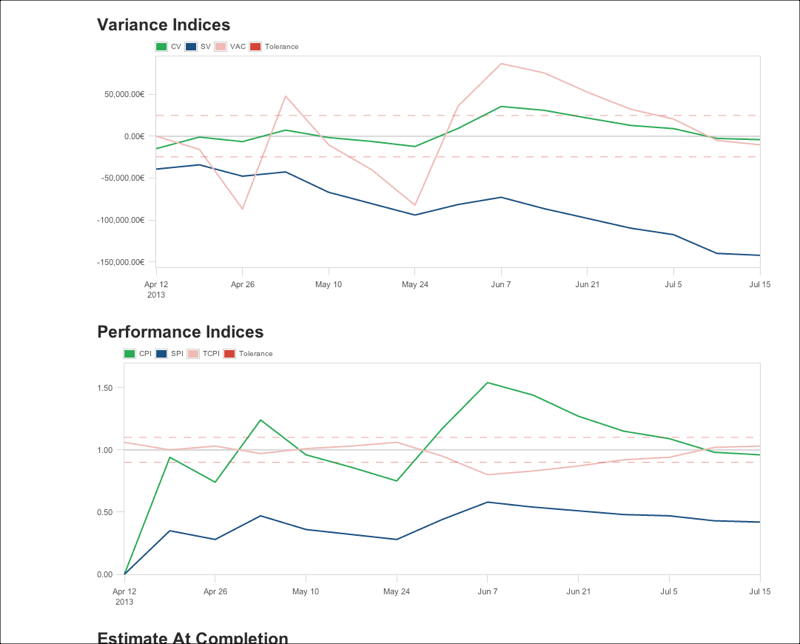
Exporting to Excel
The Indices report can be exported to Excel format to give you all the latitude to generate your own graph. Do it by selecting the "Export to Excel" item in the report's action menu found at the top right of the report's parameters panel or by hit "x".

The parameters that were used to generate the report can be found on the second tab of the generated spreadsheet. On the parameter sheet you get all acronyms definitions and the formulas used to calculate indices
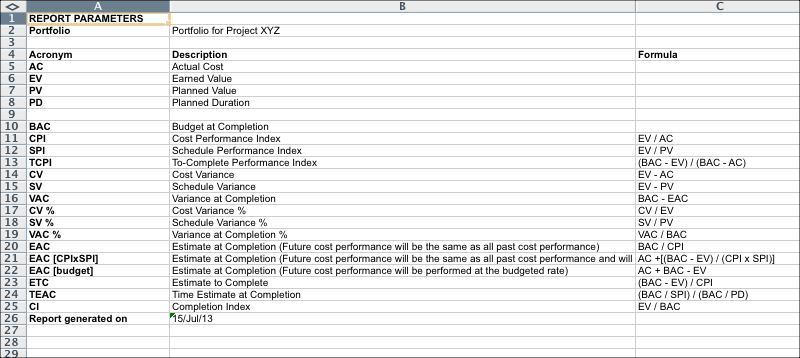
Related pages:

